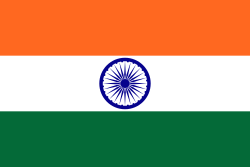Tuljapur
| Tuljapur तुळजापूर | ||
|---|---|---|
| Staat: | ||
| Bundesstaat: | Maharashtra | |
| Distrikt: | Osmanabad | |
| Lage: | 18° 1′ N, 76° 4′ O | |
| Höhe: | 650 m | |
| Fläche: | 4,16 km² | |
| Einwohner: | 34.011 (2011)[1] | |
| Bevölkerungsdichte: | 8176 Ew./km² | |
 | ||
Tuljapur (Marathi:तुळजापूर) ist eine Stadt (municipal council) mit etwa 35.000 Einwohnern im Distrikt Osmanabad im indischen Bundesstaat Maharashtra.
Lage
Tuljapur liegt in der Marathwada-Region auf dem Dekkan-Plateau in einer Höhe von ca. 640 m. Nächstgrößere Stadt ist Solapur (ca. 47 km Fahrtstrecke südwestlich); die Millionenstadt Hyderabad liegt ca. 350 km südöstlich. Das Klima ist subtropisch warm; Regen fällt nahezu ausschließlich während der sommerlichen Monsunzeit.[2]
Bevölkerung
Offizielle Bevölkerungsstatistiken werden erst seit 1991 geführt und regelmäßig veröffentlicht. Der Bevölkerungszuwachs der letzten Jahrzehnte ist im Wesentlichen auf die anhaltende Zuwanderung von Familien aus dem Umland zurückzuführen.
| Jahr | 1991 | 2001 | 2011[3] |
| Einwohner | 23.012 | 31.706 | 34.011 |
Gut 90 % der Einwohner sind Hindus, ca. 7,5 % sind Moslems und gut 1 % sind Buddhisten; andere Religionen wie Jains, Christen, Sikhs etc. bilden zahlenmäßig kleine Minderheiten. Der männliche Bevölkerungsanteil ist um ca. 7 % höher als der weibliche.[4]
Wirtschaft
Die Landwirtschaft bildet die Lebensgrundlage der Region; im Ort selbst haben sich Händler, Handwerker und Dienstleister aller Art angesiedelt.
Geschichte
Über die mittelalterliche Geschichte des Ortes und der gesamten Region ist nur wenig bekannt; wahrscheinlich herrschte hier die in Daulatabad ansässige Yadava- oder Seuna-Dynastie. Im 13. Jahrhundert übernahmen das Sultanat von Delhi, später dann das in Gulbarga und Bidar residierende Bahmani-Sultanat (bis ca. 1490) die Macht. Ab dem Jahr 1656 weitete der Mogul-Herrscher Aurangzeb in mehreren Feldzügen seine Macht auch auf den Dekkan aus. In der Phase des Niedergangs des Mogulreiches okkupierte der hiesige Statthalter Asaf Jah I., der später den Titel Nizam-ul-Mulk (Urdu :نظامالملک = „Ordner des Reiches“) erhielt, die Macht und begründete den Fürstenstaat Hyderabad, zu dem auch die Marathwada-Region bis zum Jahr 1956 gehörte.
Sehenswürdigkeiten
- Wichtigstes Bauwerk der Stadt ist der Tulja-Bhavani-Tempel, der einer lokalen Abwandlung der Hindu-Göttin Durga entspricht. Nur noch wenige mittelalterliche Reste sind vorhanden; die Architektur stammt zumeist aus der Nach-Mogulzeit. Optisch beeindruckend sind das beinahe festungsartige Eingangstor sowie der mehrfach gestufte buntbemalte Shikhara-Turm über der Cella (garbhagriha).[5]
- In der Stadt verteilt stehen zahlreiche weitere Tempel.[6]
Weblinks
- Tuljapur, Infos (englisch)
- Tuljapur, Bhavani-Tempel (Wikipedia, englisch)
Einzelnachweise
Auf dieser Seite verwendete Medien
Autor/Urheber: AshwiniKalantri, Lizenz: CC BY-SA 3.0
Location map of India with Indian claimed territories in grey. Equirectangular projection. Strechted by 106.0%. Geographic limits of the map: * N: 37.5° N * S: 5.0° N * W: 67.0° E * E: 99.0° E Made with Natural Earth. Free vector and raster map data @ naturalearthdata.com.
Autor/Urheber: Anjali Sajan, Lizenz: CC BY-SA 3.0
Situated in the hilly country in Maharashtra known as the Balaghat, Tulja Bhavani temple is situated on one of the deep slopes on the ranges of the hill, in the midst of a small side valley of a stream flowing down the plateau to the west of the town The temple is enclosed with a fortress and faces the East and consists of special attributes of Garbhagriha (sanctum sanctorum) The chief shrine is cross-planned construction, the southern one opening in the courtyard, the eastern one leading to the outer Mandapam and the western to the Garbhagriha. On the northern side is a room known as the Shejaghar or bedroom of the goddess. As one enters the temple complex through the Mahadwar, on the way there is the Kallol tirth to the left and after a descent of nearly 30 steps the Gomukh tirth on the right with a small shrine dedicated to Vitthal Rakhumai nearby. Both these tirths receive perennial water flow from gomukhs. To the left near the main entrance gate leading into the courtyard is a shrine dedicated to Siddhi Vinayak. The imposing gateway is ornamented with flower and creeper patterns carved in relief. To the right of the gate is a shrine dedicated to Dattatraya and to the left residential houses of the temple priests. Occupying a central position in the courtyard, the temple mandap has two side entrances right opposite each other flanked by small columns. Supported on quite a few rows of pillars the mandap hall is 7.62 x 4.57 metres (25' x 15') beyond which is the middle part wherein is installed a marble statue of a lion in a standing posture. Herein to the right there is a small chamber housing the silver palang or bedstead of the goddess. Inside the Garbhagriha is a silver, four-arched canopy holding the delicately carved stone image of the goddess Bhavani. It is very attractive and in point of finish and execution would rival any of the best idols found elsewhere. The entrances leading from the mandap to the middle part of the chamber containing the palang (bed) and that of the Garbhagriha are all plated with silver bearing beautiful carvings and are fine pieces of sculptural ingenuity. The Garbhagriha is crowned with a beautiful tapering sikhar having figure-filled niches. Figures set-in in the niches are mostly those of sages and deities and are very shapely. Its four corners are fixed with temple replicas also set-in with deity figures each temple replica in turn being flanked by two lion statues. The space in between is filled with elephant statues. In the front and right opposite the main entrance gate there is the homakund also crowned with a similar sikhar. Installed here and there at convenient places there are quite a few small Deepmalas or lamp-pillars. On either side of the temple, cloisters have been provided in some of which are installed idols of different deities.



